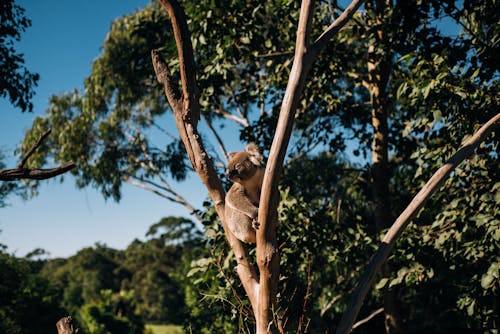The koala is a major draw for Australian zoos and wildlife parks. They are featured heavily in Australia-related advertisements, cartoons, and soft toys. If one were to name the animal most closely associated with Australia, it is very likely that the koala or the kangaroo would be mentioned. Personality-wise, the koalas’ most enduring quality is probably their laid-back nature. They generally look as happy and comfortable being in the arms of humans as they are climbing trees and eating eucalyptus leaves. The name “koala” comes from an Aboriginal word which means “no drink”. This word is given to them because the aborigines found that the koalas do not drink water, as they receive most of their hydration from the Eucalyptus leaves which they eat. They only drink when they are ill or at times when there is not enough moisture in the leaves.
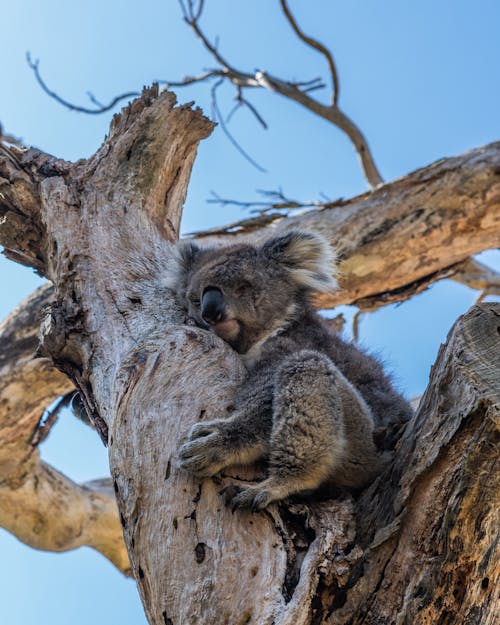
There were once several different kinds of koala—all but one of which had died out. Evidence of a “giant” koala, which was more than twice the size of its modern descendants, exists in fossils dating back more than 40,000 years. Mentions have been made associating the koala with the Marsupial Lions, the carnivorous pre-historic animals, which is said to be one of the few possible ancestors of the cute and cuddly koalas we know today.
There was very little of the habits of the indigenous plants and animals of Australia that the Aborigines did not well understand. The Aborigines have legends or, at least, ascribed reasons for all the little ways, tricks and habits of plants and animals. Therefore, they of course have a rich and varied collection of legends about koalas and symbolisms attached to them.

The koala is such an important part of the aboriginal culture that they are associated closely to the Aboriginal ancestral beliefs. They are also featured frequently in Aboriginal arts and Dreamtime legends. The Tharawal tribe believed that the koalas helped row the boat that brought them to the continent. Another myth tells of how a tribe killed a koala and used its long intestines to make a bridge for people from other parts of the world. Tribes in both Queensland and Victoria see the koala as a wise animal and sought its advice.
The story of Koobor, the koala boy, is perhaps one of the most well-known legends of the first koala. There was once a young boy named Koobor whose parents died, and who was left in the charge of his aunt and uncle. Australia was a dry land at the time and water was hard to come by, but his greedy aunt and uncle would not share their water with him and forbade him to drink the water they had collected from the creek. Whenever they left the hut, they would hide the water vessels so that Koobor would not be able to find them. Whenever he was very thirsty, Koobor was forced to eat eucalyptus leaves.
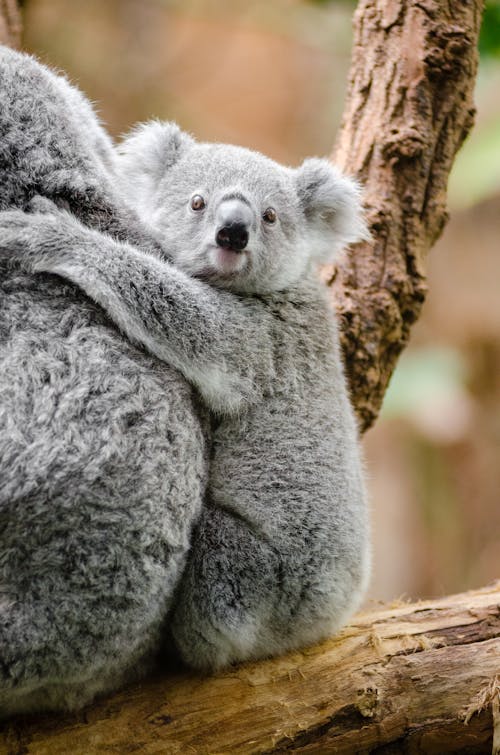
One day, his aunt and uncle went off into the bush for the day to hunt for food. They unintentionally left their water vessels in a place where Koobor could reach them. As soon as they were out of sight, Koobor excitedly took the opportunity to drink. However, after thinking of what might happen when his aunt and uncle returned, Koobor was afraid. He then took some full vessels and hung them among the branches of a small tree. After that, he climbed into the tree himself, and began to sing an ancient song. To his surprise, the tree began to grow taller and taller until he was high above the forest floor.
At dusk, his aunt and uncle returned, tired and thirsty. They immediately looked for their water vessels, but the water vessels were nowhere to be seen. Then they saw Koobor sitting in the tree, with the water vessels beside him. They spoke gently to Koobor, telling him they were sorry they had treated him badly. They promised him that, if he would come down and bring the water with him, they would be kind to him. Koobor believed them and made his way down to the ground.
As soon as Koobor reached the ground, his aunt and uncle immediately beat him with sticks and stones. They kept beating him until Koobor’s body became quite soft. Seemingly mad with anger, they continue to beat him until at last something strange happened. Koobor’s body began to change. He became shorter, stockier and covered with soft fur. He became a koala. He ran up the tree again, much quicker as he now had sharp claws, far out of his tormentors’ reach.
His aunt and uncle began to chop the tree down, hacking away until it crashed to the ground, spilling the water vessels as it did so. The water poured down, flooding across the forest floor as a mighty creek, drowning the aunt and uncle as the koala-boy jumped off and disappeared for ever into the night.
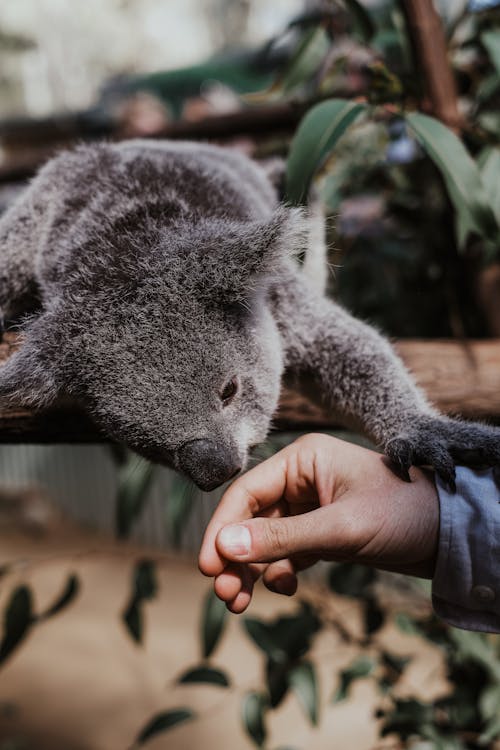
Since that time, the Aborigines are forbidden to break the koala’s bones when they kill it. Though they may eat the animal, they may not skin it, and they must always treat its body with respect. However, the koalas were still hunted for food by Aboriginals. A common technique used to capture a koala was to attach a loop of ropey bark to the end of a long, thin pole, forming a noose. This would be used to snare an animal high in a tree. The koala would then be brought down and killed with a stone hand axe or a waddy (hunting stick). According to the customs of some tribes, the head of a koala is especially sacred and would be saved for burial.
One time, a koala and the fabled bunyip were close friends. None of the other koalas approved of the friendship that existed between one from their race and a bunyip. The bunyip—a dangerous creature of the swamps—was hated, but the koalas were loved for their gentleness.

However, because of this friendship, the koala became reckless and mean-spirited. She would follow the bunyip everywhere, disturbing and hurting humans as well as other animals. Because of this, the koalas were worried that their security would be endangered. Even then they were aware of the familiar advice “choose your friends wisely” and the bunyip was not a wise choice for a friend. But the erring koala took no notice of their worries. Another cause of their worry was that this koala had a child. She left her young one unattended while she philandered with the bunyip.
In their desperate attempt to get their friend back, the koalas decided to call the guardian spirit. The spirit came, and when the koala again went up the mountain leaving her young one unprotected, the spirit held the child as the other koalas waited for her return. When the koala returned, the spirit made her child spring upon her back and cling there night and day so that the mother could not freely come and go from her tribe and fraternize with the bunyip as before. The young one clung tightly to its mother and she could not shake it off.
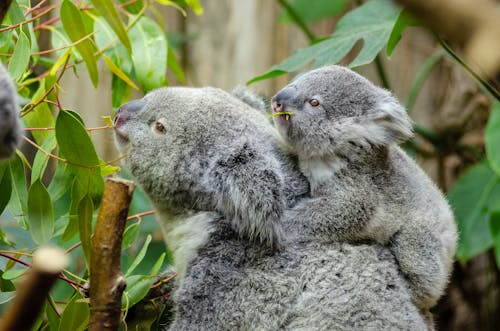
In her attempt to escape, the mother roughly smeared her child’s face with pipe-clay, and the child cried as the pipe-clay hurt its eyes. The rest of her tribe punished her for this because it was their belief that no mother should harm her child. The ancient law decreed that should a mother ever needed to punish her child, she must first pray and ask the ancestors’ forgiveness. However, even with pains in its eyes and pipe-clay all over its face, her child still clung to her. To this day, it’s said all young koalas cling to their mother’s back and the mothers are so hampered physically that they never move far from the spot where they were born – and thus the mother could never see the bunyip again. If one looks closely into the face of a koala, one may see the partially-closed eyes, and the particular parting of the hair on its face to correspond with the clay marks, a reminder of the one time a koala ever harmed its child.
Aboriginal wisdom connects koalas with the Great Mother Earth. The koalas were originally burrowers for the most part, although today they are better known as arboreal animals. One would be able to detect this in the koala’s marsupial pouch designs. Most marsupial pouches, like kangaroos, open upwards, but the opening of koala pouch is directed toward the hind quarters. This design would have protected the young koalas from dirt burrowed by early koala mothers.
Ancient Aboriginal wisdom recognizes the special relationship between the koalas and the earth. For the Aborigines, the symbolic meaning of koalas is that of connection, protection and memory because of their original affinity to ground dwelling life.
Some Aboriginal legends claim koalas were, at first, earthy clumps of grey clay. They crawled from their clay-bound lives in order to bring sacred earthly wisdom to humans. The koalas were also said to teach humans how to climb trees in order to gain a broader view of the world in which they live.
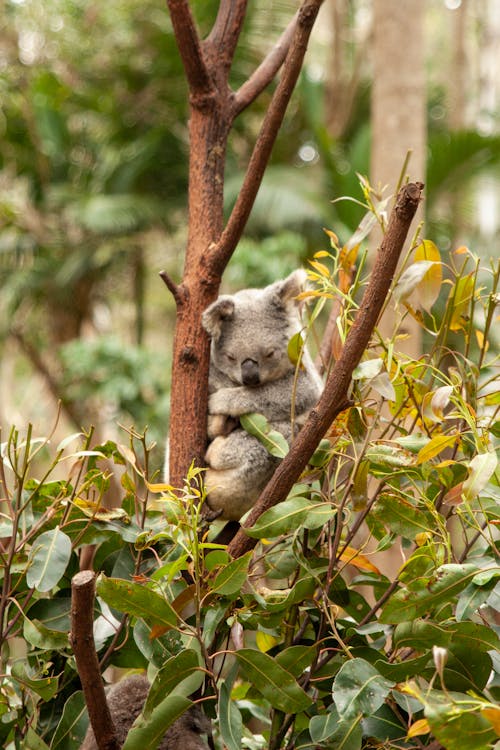
As they were many Aboriginal tribes in Australia, there are also many versions of the legends and symbolisms for the koalas. Some Aboriginal legends say that the koalas are the memory-keepers of an ancient tribe of beings before the existence of humans. Other Aboriginal legends say the original people of the earth were turned into koalas to protect themselves when the waters of the lands dried up. They then climbed the tops of trees to drink the first rains and eat the moisture-filled leaves of the eucalyptus. The fact that the koalas evolved into almost an exclusively arboreal life also symbolizes connection. Trees symbolize the sense of being grounded through their roots, the nature of progress through their growth, and connecting energy between the earthly and the ethereal realms. Trees are the bridge between heaven and earth as they are rooted in the earth while their branches and leaves reached the heavens, much like mountains in Asian mythology. For the ancient Aborigines, trees are also memory-keepers. The Celtic Druids recognized this and believed that trees were layered with esoteric history. Aboriginal myths also point to the same kind of ancient memories held within woody vessels. Another aspect of this legend says that these first koalas keep watch for their human ancestors’ return in their true form to the lands and re-populate the earth so they could re-educate the people of the sacred ways and the holy wisdom of living with earth in harmony. The role of the koalas in this case is that of protectors. They protect themselves, the memories and practices of the ancestors, as well as honor the environment.
